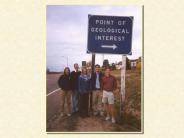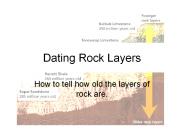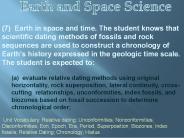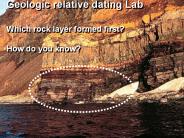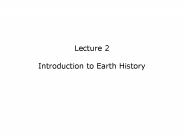Unconformities PowerPoint PPT Presentations
All Time
Recommended
EARTHQUAKES. OTHER EARTHQUAKE FEATURES. TECTONIC CREEP. Fault has continuous movement over time. ... Focus of Earthquake. GEOPHYSICAL PROPERTIES OF THE EARTH ...
| PowerPoint PPT presentation | free to download
Unconformities. Remember that these are gaps in time. Angular unconformity. Nonconformity. Disconformity/paraconformity ...
| PowerPoint PPT presentation | free to view
Siccar Point, Berwickshire, Scotland. James Hutton (1788) ... Principle of Original Horizontality - sediments are deposited in horizontal layers ...
| PowerPoint PPT presentation | free to view
Geologic Time Relative vs. Absolute Time Stratigraphy and Relative Time Relationships Unconformities and Gaps in Stratigraphic Record Stratigraphic Correlation
| PowerPoint PPT presentation | free to view
Lecture 10 Stratigraphy and Geologic Time Stratigraphy Basic principles of relative age dating Unconformities: Markers of missing time Correlation of rock units ...
| PowerPoint PPT presentation | free to view
Abundant unconformities reflecting the times of vertical movement Isostacy: why portions of the Earth s crust are at different elevations How collision builds ...
| PowerPoint PPT presentation | free to download
Lithofacies = a consistent lithologic character within a formation. ... Major unconformities representing Earth's broad tectonic or eustatic events. Sloss (1963) ...
| PowerPoint PPT presentation | free to view
Time and Geology The Key to the Past Relative Time- this rock is older than that Principles Used to Determine Relative Age Unconformities Correlation The ...
| PowerPoint PPT presentation | free to view
Sequence stratigraphy grew out of seismic stratigraphy; unconformities are easily distinguished in seismic records, but lithology is often unknown.
| PowerPoint PPT presentation | free to download
Rocks, fossils, and time. Chapter 5. continued. Last class. Stratigraphy. Unconformities ... Easiest for critter with hard parts (shells, bones, teeth) ...
| PowerPoint PPT presentation | free to view
Three types of unconformities include; 1) Angular Unconformity. 2) Disconformity ... inclusions. Cross-cutting. Angular. unconformity ...
| PowerPoint PPT presentation | free to view
... unconformities, and correlation of rock units and fossils ... by fossils ... appearance of complex life; many fossils. Geologic Time Scale. Mesozoic era ...
| PowerPoint PPT presentation | free to view
Law of Superposition. Uniformitarianism. Unconformities. Absolute Time ... Molecular Clocks. Paleobiology The History of Life. Origin of Life. History of Life ...
| PowerPoint PPT presentation | free to download
Often plutons are many km below the surface. Review of Unconformities ... 1) formation of pluton deep underground. 2) erosion of several km of overlying rock ...
| PowerPoint PPT presentation | free to view
Figure 9.2. Geologic Time. Superposition and Original Horizontality ... Figure 9.8. Figure 9.5C. Inclusions. Figure 9.6. Unconformities. Figure 9.9. Correlation ...
| PowerPoint PPT presentation | free to view
Title: Chapter 8: Major Elements Author: John D Winter Last modified by: John D Winter Created Date: 1/27/1997 12:16:50 AM Document presentation format
| PowerPoint PPT presentation | free to download
Geochronology - Key . Title: RELATIVE DATING: Determining whether an object or an event is older or younger than other objects or events. Author: Troy Haney
| PowerPoint PPT presentation | free to download
PRELIMINARY SEQUENCE AND EVENT STRATIGRAPHIC CORRELATIONS WITHIN THE HELDERBERG GROUP SILURIANDEVONI
| PowerPoint PPT presentation | free to download
... a G p S s t F T O d f e ... a G p S s t F T O d f ...
| PowerPoint PPT presentation | free to download
Geology 10.09.07 / 10.10.07
| PowerPoint PPT presentation | free to download
... formed by Rock B was a sill? Give the evidence from the graphic log that shows that these rocks were laid down in a fluvial environment.
| PowerPoint PPT presentation | free to download
the fundamental principle that geological processes and natural ... Cosmogenic. Radioactive Decay Systems. Radioactive Decay Systems. 238U 206Pb. Absolute Time ...
| PowerPoint PPT presentation | free to view
Title: GEOL 1307 Physical Geology Author: Dr. Brad Hoge Last modified by: GX620 Created Date: 10/19/2006 8:46:25 PM Document presentation format
| PowerPoint PPT presentation | free to download
Title: Stratigraphy & Relative Dating Author: kisd Last modified by: KISD Created Date: 3/23/2006 9:44:38 PM Document presentation format: On-screen Show
| PowerPoint PPT presentation | free to view
Dating Rock Layers How to tell how old the layers of rock are. What is Age? There are 2 kinds: Absolute Age The number of years since the rock formed.
| PowerPoint PPT presentation | free to download
LINKAGE BETWEEN FLUVIAL SHEET SANDS AND THEIR TIMEEQUIVALENT SHORELINE AND SHELF SANDS U' CRETACEOUS
| PowerPoint PPT presentation | free to download
Dating Rock Layers How to tell how old the layers of rock are. What is Age? There are 2 kinds: Absolute Age The number of years since the rock formed.
| PowerPoint PPT presentation | free to download
Agents of What do fossils show? How can rock layers change? How do fossils form? How old are rock layers? 100 100 100 100 100 200 200 200 200 200 300 300 300
| PowerPoint PPT presentation | free to view
Unit 5: Age of the Earth Objective: E5.3D Describe how index fossils can be used to determine time sequence. E5.3g Identify a sequence of geologic events using ...
| PowerPoint PPT presentation | free to download
Principle of Original Horizontality. Principle of Original Continuity ... Original Horizontality. Original Continuity. Crosscutting Relationships. Unconformity ...
| PowerPoint PPT presentation | free to download
(7) Earth in space and time. The student knows that scientific dating methods of fossils and rock sequences are used to construct a chronology of Earth's history ...
| PowerPoint PPT presentation | free to download
Erosion, & Types of Weathering Chapter 10 Erosion A process where water, wind, or gravity transports soil (sediment) from its source The process by which rocks are ...
| PowerPoint PPT presentation | free to download
Relative Dating (No, not your cousin) Finding the Relative Age of Rocks Relative Dating and Relative Age Scientists use relative dating to determine whether a rock is ...
| PowerPoint PPT presentation | free to download
Absolute & Relative Dating Alex Burkett, Eric Francey, Juliet Collados Introduction Geologists estimate that the earth is about 4.6 billion years old James Hutton ...
| PowerPoint PPT presentation | free to view
It was recognized in the 1600's that in a sedimentary ... Biostratigraphy. Newer subdisciplines. Seismic stratigraphy. Cyclostratigraphy. Magnetostratigraphy ...
| PowerPoint PPT presentation | free to download
Which rock layer formed first? How do you know? Relative Dating Lab Which geologic event occurred first?? Geologic relative dating Lab Relative Dating: Unraveling ...
| PowerPoint PPT presentation | free to download
Virtual field sites provide motivation for looking at geology in person. Future Possibilities ... field site of exposed geology. Take pictures, collect samples ...
| PowerPoint PPT presentation | free to download
Lithostratigraphy a. description of unit properties (e.g. color, texture, particle shape, stratification, lithology) b. named after dominant grain size fraction c. ...
| PowerPoint PPT presentation | free to view
Lecture 2 Introduction to Earth History
| PowerPoint PPT presentation | free to download
a man in the 18th century named James Hutton invented it 'current geologic process such as volcanism and erosion are the same processes ...
| PowerPoint PPT presentation | free to view
The study of strata (layers) of rocks with an eye toward ... http://lists.uakron.edu/geology/natscigeo/Lectures/time/gtime1.htm. Stratigraphic Principles ...
| PowerPoint PPT presentation | free to view
GE0-3112 Sedimentary processes and products Lecture 13. Sequence stratigraphy Literature: - Leeder 1999. Ch. 14. Changing sea level and sedimentary sequences.
| PowerPoint PPT presentation | free to download
Stratigraphy The study of strata (layers) of rocks with an eye toward interpreting the geologic history of the region Closely tied to dating methods
| PowerPoint PPT presentation | free to download
Falling-stage (forced regressive) systems tract (FSST) Lowstand systems tract (LST) ... that are very similar to those formed by RSL change (except for forced ...
| PowerPoint PPT presentation | free to view
How to Match Correlate Rock Columns
| PowerPoint PPT presentation | free to view
Preservation in amber hardened resin of ancient trees surrounds an organism ... Proposed by William Smith late 1700s and early 1800s. Determining the ages of ...
| PowerPoint PPT presentation | free to download
Title: Volcanoes and Igneous Activity Earth - Chapter 4 Author: Stan & Cindy Hatfield Last modified by: Owner Created Date: 12/18/2000 12:31:17 AM
| PowerPoint PPT presentation | free to download
Talk Organization Sedimentary Analysis & Sequence Stratigraphy History of Sequence ... facies assemblages & system tracts as templates for depositional ...
| PowerPoint PPT presentation | free to download
The fact that Earth has changed through time is apparent from evidence in the geologic record ... 40,000-year-old frozen baby mammoth found in Siberia in 1971 ...
| PowerPoint PPT presentation | free to download
Title: No Slide Title Last modified by: sunil.yadav Document presentation format: On-screen Show Other titles: Times Arial Wingdings Times New Roman Default Design ...
| PowerPoint PPT presentation | free to view
End of Snowball Earth. Warmer in Cambrian and Ordovician ... Historical geology provides past geologic and paleogeographic reconstruction of the world ...
| PowerPoint PPT presentation | free to download
... a geologic column, which is a composite column containing, in chronological order, the succession of known strata, fitted together on the basis of their ...
| PowerPoint PPT presentation | free to download
Propagation of seismic (elastic) waves, reflect back, picked up by detectors ... packages of stratal units to accurately correlate coeval (equivalent age) ...
| PowerPoint PPT presentation | free to view
WJEC A2 Geology BGS Mapwork I.G.Kenyon BGS 1:50.000 scale maps 1mm on the map represents 50m on the ground Grid squares are 1 km and have sides of 2cm on the map ...
| PowerPoint PPT presentation | free to view

